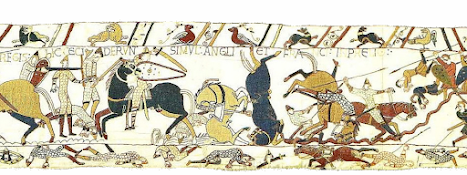King and Conqueror - The continuing story of William and Harold
Hi,
This blog will be about the content of the television programme " King and Conqueror" not its participants. I'll let you decide whose acting is best/worst/indifferent, you don't need me for that.
Let me introduce myself. I'm Kevin and I've been researching the Battle of Hastings for about 10 years. I'm a electronics engineer by training and education having walked the route from avionic repair technician to licensing of Satellite Ground Stations and other such duties in the Radiocommunications Agency. My interest in the battle of Hastings started when Nick Austin and John Grehan published books on alternative sites for the battle. Mix in my favourite Sunday night programme, Time Team and you've piqued my interest. So, starting with D.M Wilson's excellent book on the Bayeux Tapestry I started my own research. I have since acquired authoritative translations of the other three 11th century reports of the Battle ( EMC Van Houts, Davis and Chibnall and K Tyson). Now, my collection of 12th century reports is a bit mixed. While Orderic's missive and the Chronicle of Battle Abbey are authoritative translations ( Chibnall and Searle), The Chronicle of Henry of Huntingdon and Chronicle of the Kings of England by William of Malmesbury are translations made by reverends in the 19th century. The final two reports, Wace's Roman de Rou and Anglo-Saxon Chronicles, are translations by G.S. Burgess and M. Swanton respectively.
I have a few contemporary books on the Battle which include R Allen Brown's book " The Norman Conquest of England" and "The Battle of Hastings" by Stephen Morillo. Let's finish with my least favourite author, Marc Morris and his book " The Norman Conquest".
I've also spent some time researching Edward, Harold's predecessor and his role in the story of England. So, for him, I scoured Frank Barlow's tome and that of Tom Licence. Also included in my quest for the man that was Edward, I delved into two books that don't get a mention in polite society, namely the puff piece written by St Ælred of Rievaulx and "The Life of St. Edward, King and Confessor" by R.F. Jerome Porter - another puff piece.
King and Conqueror
I'm not holding out much hope for this series as this is what we read in the promotional material from the BBC :-
King and Conqueror is the story of a clash that defined the future of a country – and a continent – for a thousand years, the roots of which stretch back decades and extend out through a pair of interconnected family dynasties, struggling for power across two countries and a raging sea. Harold of Wessex and William of Normandy were two men destined to meet at the Battle of Hastings in 1066; two allies with no design on the British throne, who found themselves forced by circumstance and personal obsession into a war for possession of its crown.
Nothing that I've read gives a hint that Harold and William were allies. The story as I understand it is :-
Back in the day, Æthelred was concerned with Viking raids carrying off his population as slaves to be sold at market in Normandy. He was advised to marry the offspring of Richard I, Duke of Normandy in the hope that he could persuade Richard to stop the Vikings selling English slaves. Now Æthelred had five sons so any offspring from the union with Emma had little chance of progressing to the top job. Emma however, had two boys and a girl. By the time Æthelred popped his clogs only two of the original sons were still alive ( Edmund and Eadwig). Edmund was considered unsuitable as King and Eadwig was too. The job went to Canute, who outlawed Eadwig only to pardon him later ( only for Eadwig to be murdered!). In the meantime, after waiting for a year to pass, Emma married Canute and had another son, Harthacnut. The Danish interregnum lasted from 1016 to 1042 when it reverted back to "English" control. Even then it was meddling by Emma that caused it. She had Harthacnut declare Edward co-regent so that when Harthacnut died ( unexpectedly!) Edward didn't have to face selection by the Witan to get the top job.
Fast forward to 1051-ish, William visits his erstwhile cousin once removed ( Emma was his grandfather's sister) and goes away convinced he's been promised the throne. Now, it's time for the tin foil hat! In France at this time all titles were hereditary including the top job of King. So what convinced William he was in line for the English throne when a different procedure was used? Using consanguinity from Roman times William was five whereas Eadgar was four but if it was determined by the closest common ancestor then William was three as was Eadgar. Because of the contemporary records from the Anglo-Saxon Chronicles and and William of Jumièges, using words like underfang ( vassal - Marc Morris) and dominus ( Head of the Family) I suggest that Edward was not who he said he was and was Duke William's supposedly dead uncle William.
The second mistake in the blurb from the BBC is "British" Such a simple mistake that any school child would be quick to correct. We are in fact talking about the English throne. The British throne wouldn't come into existence for another 600 years or so.
So when King and Conqueror comes to Norway I'll give you chapter and verse on any deviations from the sources. You can make your own mind up as to whether the said deviances were plot holes or devices!






